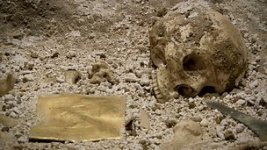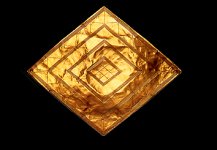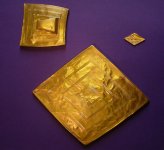100th Monkey
New member
The strange Gold pieces from Stonehenge:



Source:
Wiltshire Heritage Museum : Galleries
THE STORY and THE MISTERY
Bush Barrow Lozenge Part 1
PART 2:
Bush Barrow Lozenge Part 2



Bush Barrow is a site of the early British Bronze Age (ca. 2000 BC), at the western end of the Normanton Down Barrows cemetery.
It is among the most important sites of the Stonehenge complex. It was excavated in
1808 by Sir Richard Colt Hoare and William Cunnington. The finds are displayed at Wiltshire Heritage Museum in Devizes.
The barrow contained a male skeleton with rich funerary goods, including a large 'lozenge'-shaped sheet of gold, a sheet gold belt plate, three bronze daggers, a bronze axe, a stone macehead and bronze rivets.
One bronze dagger has a hilt that was decorated by as many as 140,000 gold pins set to make a herringbone pattern.
The finds have been called "Britain's first Crown Jewels" belonging to the "king of Stonehenge".
The design of the artifact known as the Bush Barrow Lozenge, and the smaller lozenge, has been shown to be based on a hexagon construction.
Detailed analysis of the design has shown both the shape and the decorative panels to have been created by repeating hexagons within a series of three concentric circles (each framing the series of smaller decorative panels).
The precision and accuracy displayed by the work demonstrates both a sophisticated tool kit and a sound knowledge of geometric form.
The myriad of minute fine gold wire pins set within the dagger handle (above) is further testimony to the sophisticated level of skill and expertise of contemporary Bronze Age artisans. A similar gold lozenge from Clandon Barrow, in Dorset, used a decagon in its design.
The barrow is one of the "associated sites" in the World Heritage Site covering Stonehenge, Avebury and Associated Sites (Cultural, ID 373, 1986).
Source:
Wiltshire Heritage Museum : Galleries
THE STORY and THE MISTERY
More here:In the year 1808, Sir Richard Cott Hoare and William Cunnington conducted a significant archaeological excavation into a tumulus mound, situated only a short distance from the Stonehenge monument.
Workmen uncovered the remains of a tall, well built man lying in a fully extended position with his head pointing toward the south.
The grave also contained an assortment of valuable artefacts, including 3 fabricated from beaten gold, attesting to the individual's importance and station within his ancient society. Because of the presence of daggers and an axe, the deceased man was initially thought to have been a warrior.
The totality of the artefacts recovered, however, suggested that the individual had functioned in the capacity of a priest or architect at Stonehenge, as the items found with the skeleton gave an appearance more akin to ceremonial or calculation usage.
Some preliminary assessments related to wooden items in an advanced state of decay were later modified to support a scientific function rather than a combative one.
Of these items Professor John North comments, 'Fragments of wood that the excavators had thought were the remains of a shield were now described as the remains of an alidade (a sighting rule) and wooden drawing board or plane table' (see Stonehenge, Neolithic Man and the Cosmos, page 508).
There were three daggers with bronze blades and wooden handles. A series of gold pins had held the wooden handles to the blades. Other items included a bronze axe, as well as a mace with a circular pebble head and bone inlaid wooden handle.
The 3 gold artefacts consisted of two intricately patterned, flat, diamond shaped objects, overlaying a wooden base and another item thought to have been a belt buckle or buckle loop.
Of the two diamond or lozenge shaped artefacts, one is considerably smaller than the other and might have been a forehead ornament. Its larger counterpart, with a length of 7.28 inches and a breadth of 6.14 inches, was undoubtedly used as a breastplate ornament. This conclusion is supported by the fact that it was found on the breastbone of the skeleton. It also contains small, drilled or punched holes at its lengthwise ends, consistent with suspending the item from the neck by a cord and having it lie against the chest.
Figure 1: The three gold items recovered from the tumulus grave near Stonehenge. They are presently in the collection of the Devizes Museum at Wiltshire, England.
In the past two centuries there has been considerable speculation regarding an astronomical function or mnemonic usage for the larger lozenge shaped artefact, now popularly referred to as the Bush Barrow Lozenge.
However, to date, no definitive explanations have been forthcoming demonstrating how it could have been used in any such capacity. Until a scientific capability is clearly found within the intricate patterning of the lozenge, scholars must assume it had a solely decorative or ceremonial function, or that it was a symbol of office.
THIS ANALYSIS WILL DEMONSTRATE THE FOLLOWING:
(A). That the Bush Barrow Lozenge was built as a memory device, with certain aspects specifically tailored for usage at Stonehenge.
(B). That the lozenge contains multiple coded relationships, which link mathematical endeavour at Stonehenge to similar endeavours upon the Giza Plateau of Egypt.
(C). That the measurement standard used in the construction of Stonehenge was the British standard inch and that this measurement system has a pedigree back to the Great Pyramid of Egypt, as well as Khafre & Menkaure Pyramids.
It will be shown that the British/ Egyptian/ Babylonian/ Sumerian system of measurement has not drifted or been subjected to serious alteration since megalithic times and its integrity remains intact to the present day.
(D). That ancient mathematicians of Britain, as elsewhere, understood the ratios PI (3.1416) and PHI (1.6180339) or the use of 3,4,5 triangulation, millenniums before Pythagoras.
(E). That a singular, universal astronomical system was adopted and used by many widely scattered civilisations, incorporating the same sets of numbers and measurement increments. These selfsame numbers and methods were used in many climes and at many latitudes to determine celestial cycles, to navigate or for surveying and overland mapping.
The Lozenge artefact has been scaled according to the finite dimensions provided by the Devizes Museum Curator, Mr. Paul Robinson, who wrote:
Dear Mr Doutre
Thank you for your enquiry. There are, I am afraid, no closely accurate measured drawings of the lozenge as yet. The total dimensions (edge to edge) are 185 x 156 mm. The dimensions from the corners of the outermost engraved lines are 180 x 153 mm.
These measurements are taken from a high quality electrotype facsimile of the lozenge made in 1920. The lozenge itself suffered an accident in the 1980's with the result that it is believed that it may have been slightly distorted in its repair. Leastwise any measurements now taken from the original cannot be guaranteed as accurate.
Hope this helps. Let me know if you need any further assistance.
Yours sincerely,
Paul Robinson,
Curator.
No attempt has been made to draw a geometrically perfect lozenge and although, for the purposes of this study, a drawing of the artefact will be used, it is precisely representative of the actual artefact.
Any pattern variation, linear deviation or edge damage has been accurately copied and used in the drawn replica.
All drawn replication of the Bush Barrow Lozenge was done over a precisely scaled photograph of the original artefact, adjusted as per the dimensions given by the Curator, Mr. Paul Robinson, to eliminate any minor optical distortion.
This was done in the highly precise, architectural computer program, AutoCAD using the magnification component of CAD to ensure tremendous accuracy and finite detailing.
Every attempt is made to represent the Lozenge according to how ancient mathematicians designed it and artisans fabricated it. Some minor discrepancies will be seen in the demonstration of certain codes.
This is, primarily, because the most apparent means of finding the Lozenge centre (intersecting cross-lines in the most central lattice diamond) shows the centre to be displaced to the left by an average of .01455".
Alternatively, the centre displacement, top and bottom averages .02105" toward the top.
These assessments are based upon how the lozenge is orientated for the purposes of this study and that aspect will remain constant throughout.
The analysis will show that many of these slight inexactitudes were deliberately incised into the lozenge in an individual section or quarter for the accentuation of particular codes.
Some minor discrepancies in the geometry might be due to damage to the lozenge or visual limitations on the part of the artisan who did the fine engraving.
Although the geometry will sometimes drift marginally off position, it is visually clear enough to demonstrate what the design intention was of those who conceived, fabricated and numerically coded the lozenge.
Fulcrum points for the demonstration of codes will be the four cardinal, extreme outer points of the lozenge and the four cardinal points of each reducing pattern. Another primary fulcrum will be the centre position of the most central lattice diamond.
Bush Barrow Lozenge Part 1
PART 2:
Bush Barrow Lozenge Part 2
